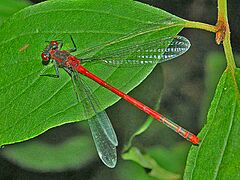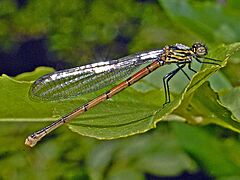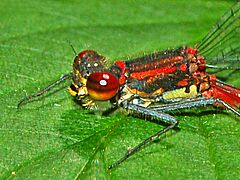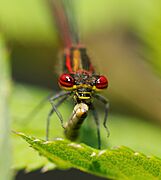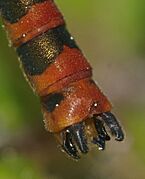Large red damselfly facts for kids
The large red damselfly (Pyrrhosoma nymphula) is a beautiful insect. It is a type of damselfly that belongs to the family called Coenagrionidae. You can find these damselflies mainly in the western part of the Palearctic, which includes Europe, parts of Asia, and North Africa.
Quick facts for kids Large red damselfly |
|
|---|---|
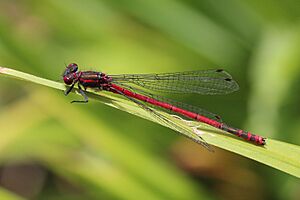 |
|
| Male, Dry Sandford Pit, Oxfordshire | |
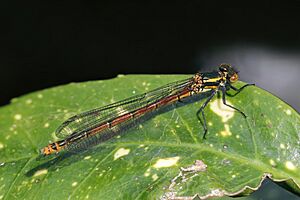 |
|
| Female, form fulvipes Cumnor Hill, Oxford |
|
| Conservation status | |
| Scientific classification | |
| Genus: |
Pyrrhosoma
|
| Species: |
nymphula
|
| Synonyms | |
|
List
Libellula minius Harris, 1782
Libellula nymphula Sulzer, 1776 Moroagrion danielli Needham & Gyger, 1939 Pyrrhosoma interposita Varga, 1968 Pyrrhosoma nymphula interpositum Varga, 1968 |
|
Contents
Where They Live
This damselfly species is mostly found in Europe. You can also spot some groups in Northern Africa and Western Asia.
Their Home
Large red damselflies like to live near water. They prefer small ponds, lakes, and ditches. Sometimes, you might find them near slow-moving rivers. They usually stay away from water that flows too fast.
What They Look Like
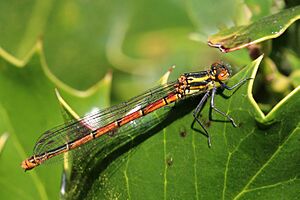
The large red damselfly, also known as Pyrrhosoma nymphula, can grow to be about 33 to 36 millimeters long. These damselflies are quite strong and easy to spot. Both males and females have black legs and black spots on their wings.
Male Damselflies
Adult male damselflies have bright red eyes. Their main body section, called the thorax, is black. It has red stripes on its shoulders. Younger males have yellow stripes instead of red ones. As they get older, these stripes turn red. Their tail, or abdomen, is red with small black rings. Near the tip of the abdomen (segments 7-9), there are bronze-black bands. Their wings are clear, and they have a small black patch called a pterostigma.
Female Damselflies
Adult females come in three main color types: typical, fulvipes, and melanotum. Their colors can range from mostly black to mostly red. However, all females have yellow bands around their abdominal segments. You might also see some females with colors that are a mix of these types.
The typical form has more black on its abdomen than the fulvipes form, especially on segment 6. In the melanotum form, the top of the female's abdomen is almost entirely black. Young females have lighter eyes and yellow stripes on their thorax, not red.
How to Tell Them Apart
It's easy to confuse large red damselflies with small red damselflies. But there's a simple trick: large red damselflies have black legs, while small red damselflies have orange legs.
In Greece and Albania, there's a very similar species called the Greek red damsel (Pyrrhosoma elisabethae). They look almost the same. The females of the Greek red damsel have a slightly different shape on their pronotum (the part behind their head). The males are different in their lower tail parts, which are longer than their upper ones. Also, the black hook on their lower tail parts is only half as long as in the large red damselfly. You can see pictures of the large red damselfly's tail parts in the gallery below.
Life Cycle and Behavior
The large red damselfly is often one of the first damselflies to appear in the spring. You can usually see them starting in April or May. Adult damselflies can be found flying around until September, depending on the area.
Growing Up
Young adult damselflies take about two weeks to become fully mature. Mating usually happens among plants. When the female lays her eggs, the male stays with her. She dips only her abdomen into the water to lay the eggs.
From Egg to Larva
The eggs hatch in about two to three weeks. The young damselflies, called larvae, live in the water. They take about two years to grow and develop. These larvae eat other small water insects, tiny living things called protozoa, rotifers, or small crustaceans.
Gallery
-
Male eating insect
Dry Sandford Pit, Oxfordshire




